I was a shy child. Consequently, I spent a lot of time avoiding eye contact by looking down at the ground. All this time looking down at my feet allowed me to regard the ground upon which I was walking. Thus it was as a Vancouver kid of the 1970s that I first noticed the glassy purple squares embedded in sidewalks.
Have you ever been walking in an older part of the city and noticed a checkerboard grid of purple squares under your feet?

No, they are not simply sidewalk decoration [wouldn’t that be nice?] but rather a system to illuminate spaces under sidewalks called areaways. Sidewalk prisms, also known as vault lights (or pavement lights in the UK), are glass prisms set into sidewalks in order to reflect the natural light from above, safely illuminating these subterranean spaces. [Why are they purple? The answer to that is at the end of the post].
The concept for areaway lights came from a similar system used on ships starting in the middle of the 19th C. Deck prisms were used to safely illuminate the cargo hold by bringing in light without the use of candles – which could prove very hazardous on a wooden ship, especially if it was carrying flammable cargo. Later in the century this system of illumination was adapted for city use, and the sidewalk prism was born.
What about areaways? In her interesting article on areaways, Justine Murdy explains that since Vancouver’s incorporation in 1886, property owners in the downtown area ( i.e. The CBD, Gastown, Chinatown) were charged “taxes for sidewalks that aligned their lots, even though using the space above the sidewalk wasn’t permitted”. Some property owners took advantage of this and decided to use the spaces below the sidewalks to expand their basement space. Murdy explains that “by paying a minimal encroachment fee to the City, basements could be extended into the area under the sidewalk” past the building wall up to the street wall. By the time areaways came into use in Vancouver, many other cities in North America and the UK were already using glass prisms to safely illuminate these spaces. The idea of lighting otherwise dark and dank areas with “pure, healthful, white light from wall to wall” was very appealing in the Victorian and Edwardian eras.
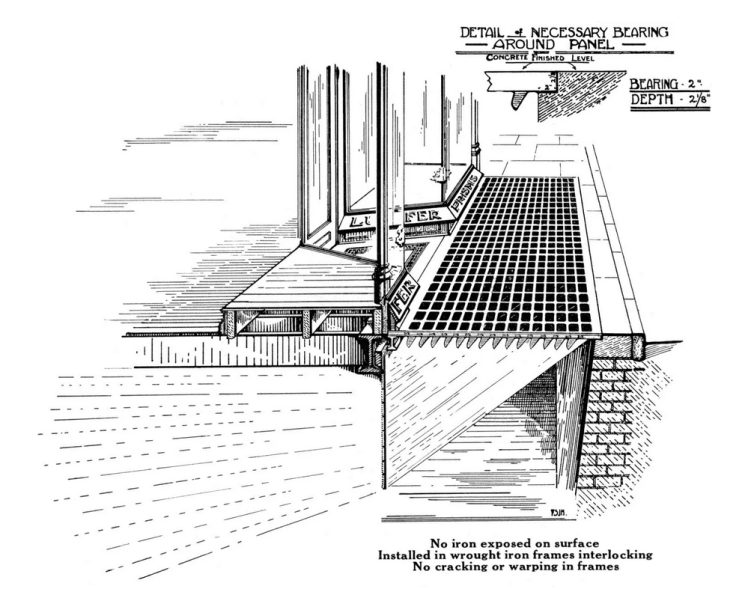
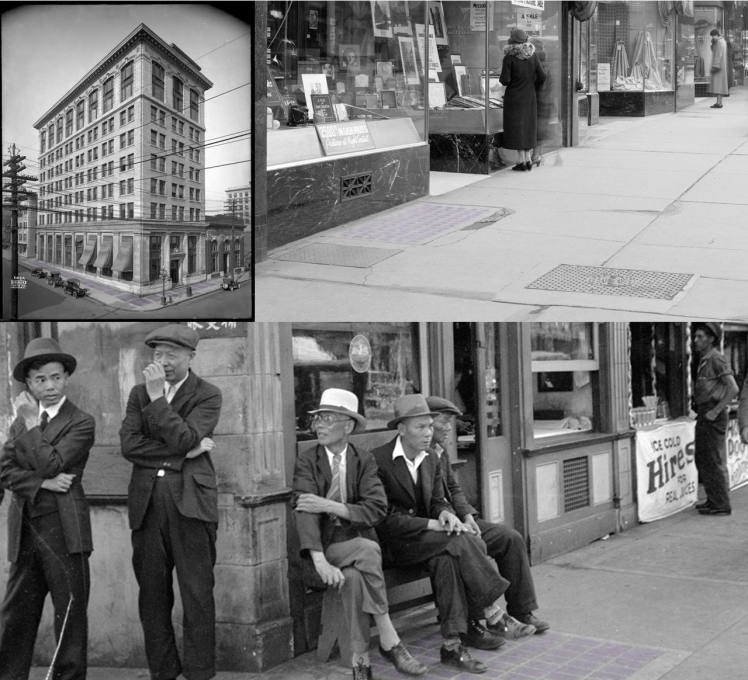
As Vancouver grew, so did its infrastructural needs. Since regular access to utilities (sewer, waterworks, electrical, etc.) was required, it made more sense for the City to use the space under the sidewalk, rather than the street [which would disrupt traffic] to run and access these utilities. At the same time, businesses were shifting away from using coal as their main heating source, so all those coal chutes leading into areaways and basements below ground were no longer needed. In some cases, areaways were taken over by the City for its own use.
The second half of the 20th Century also saw a lot of “modernization” in the city which resulted in new building projects and with them came new sidewalks, resulting in the loss of active areaways and sidewalk prisms. New safety regulations from the City engineering department also forced the closure of areaways – the sidewalk above had to be able to withstand the weight of an emergency vehicle parked on it. Areaways were filled in either permanently (with cement) or semi-permanently (with gravel). Such is the case with the historic Hotel Europe, the areaways beneath its sidewalks which once housed among other things a saloon, are now filled with gravel. This is at least a potentially reversible situation.
Sidewalk prisms are not just square shaped, but also can be round and lozenge shaped and are found regionally in many west coast cities, such as Victoria, Seattle, Portland, and San Francisco. On a 2017 trip to the “City by the Bay” I was pleased to find several fine examples of historic sidewalk prisms (or vault lights, as they were called in the US) including these (see below) outside the aptly named “City Lights” bookstore.

The best part of this discovery was being able to go inside the ca.1907 building and see the prisms from below. I was surprised to find that even though they were tinged purple, they actually let in quite a bit of light.
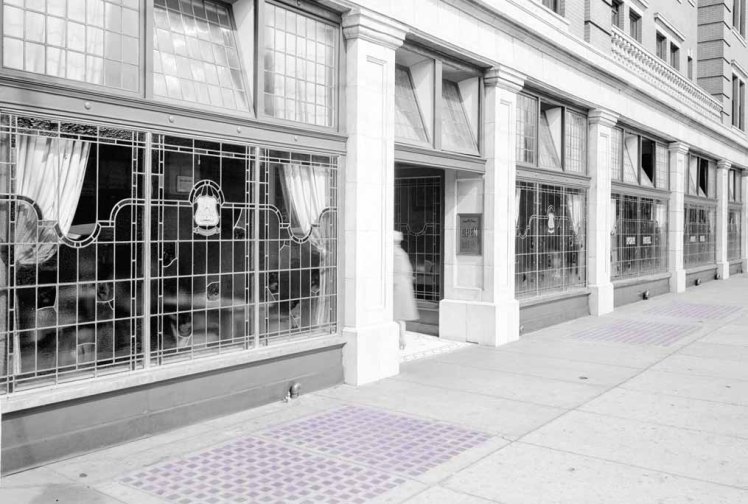
It seemed to me that I came across those ‘purple squares’ less and less over the past 20 years and I wondered just how many examples were still around in Vancouver. With a little research, I discovered this vault lights (aka sidewalk prisms) map by Samantha Knopp. I used it as a foundation and tried to locate the 12 vault (or prism) lights spots on the map.
Unfortunately, the exact locations are rather vague, and I had a little trouble at first finding the locations as indicated on the map. After some map/street orientation and then walking around trying to confirm the exact location of each spot, the primary thing I discovered is that some of the locations didn’t have any sidewalk prisms at all! My fear was that they were disappearing faster than I thought! Still, this map provided a starting point for my own discovery.
I was determined to create my own (detailed) map and walking tour of the sidewalk prisms of Vancouver primarily to determine the current state of sidewalk affairs. So, I present the result of many, many hours spent researching and walking around the city (looking at my feet). I hope that, through word of mouth, other locations will be brought to my attention and we can add them to the map.
The sidewalk prisms of Vancouver walking tour:

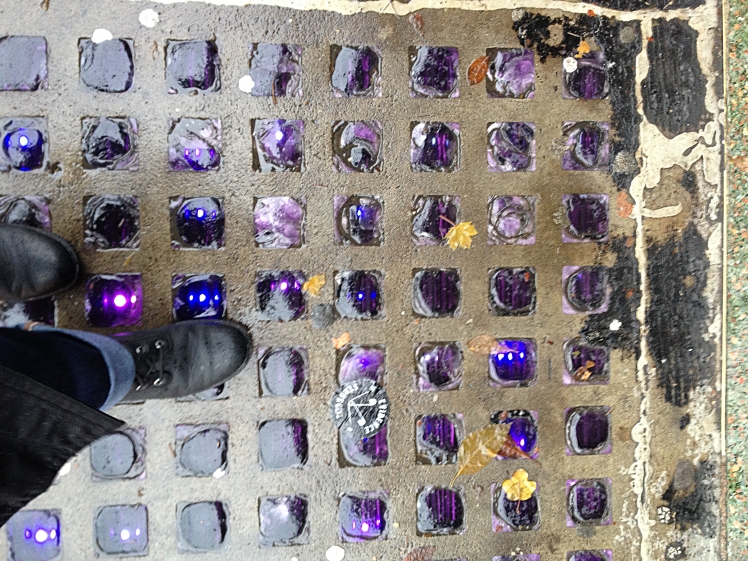
Stop #1 – 440 West Pender (in front of Bangtown Hair Salon) – Original. These are a fine example of original sidewalk prisms, enhanced by the use of lights below the surface. The building dates from 1909. This block of West Pender used to have quite a few sets of sidewalk prisms and areaways. Old photographs of the Vancouver Board of Trade Building (1913), located on the corner of West Pender and Homer, reveal that the building was surrounded by them. I recommend seeing these at night, it’s a real treat!


#2. 321 West Hastings (in front of Vinyl Records) – Restored. This is a small example of sidewalk prism lights in front of a building originally constructed in 1904. Note that this restoration using new round prisms (fairly unique, historically for Vancouver) takes into account the sidewalk load restrictions for areaways and sidewalk prisms as laid out by the City’s Engineering Department.
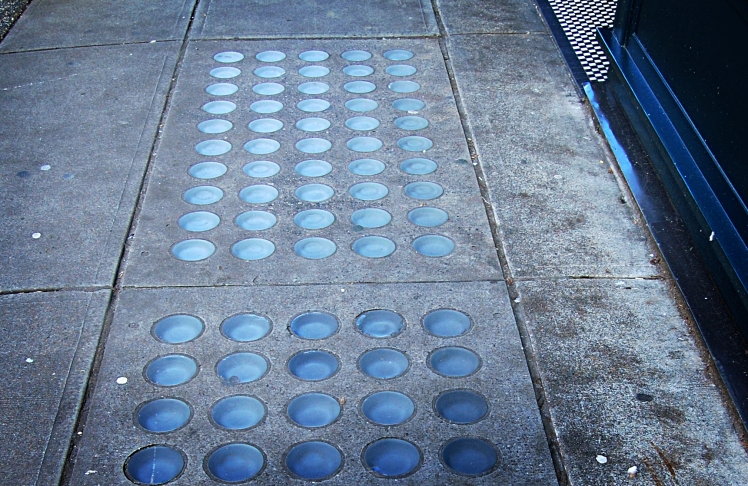
3. Sidewalk at 370 Cambie Street – Flack Building. Photo: C. Hagemoen
#3. 370 Cambie Street – Restored. Part of the Flack Building restoration of 2009, and skirting the entire sidewalk along this corner building, 370 Cambie is a great example of a restoration that utilizes the entire available areaway. Note that this restoration using new round prisms (fairly unique, historically, for Vancouver) takes into account the sidewalk load restrictions for areaways and sidewalk prisms as laid out by the City’s Engineering Department.
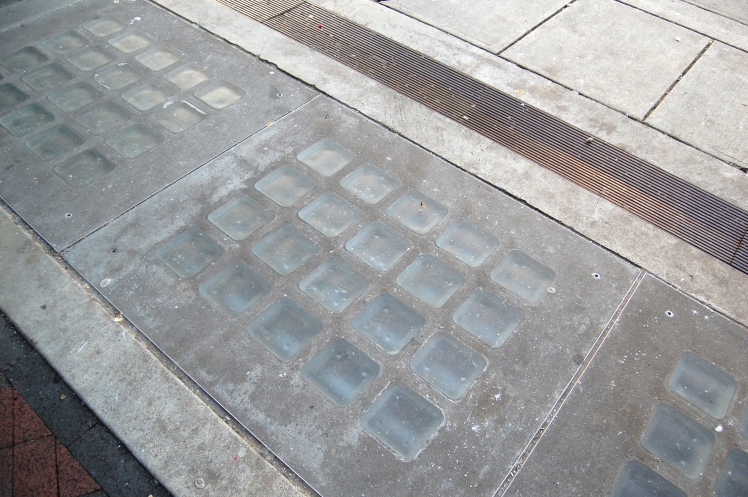
#4. 314 Abbott Street – Restored [?] The Woodward’s renovation (2010) included 3 examples of sidewalk prisms: along West Hastings, around the corner at 314 Abbott (listed here), and at 126 W. Cordova. According to city records, there used to be a tunnel and several “voids” under the sidewalks on the former Woodward’s retail property. Since they were not being used, they were filled in prior to the redevelopment of the property. Worth the stop to see the other sidewalk embellishments nearby.

#5. 18-20 Water Street – Restored. The sidewalk prisms in front of the Edwardian era Roberts Building are another great example of a modern restoration in historic Gastown. The original four-story plus lower level commercial mixed-use rooming house building dates from 1911 and is in the Vancouver Heritage Register.
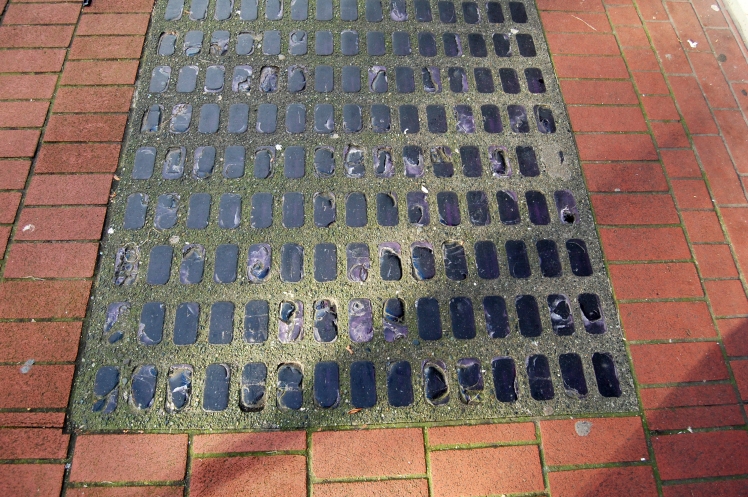
#6. 43 Powell Street – Hotel Europe (corner of Alexander and Powell Streets) – Original. A fine example of original sidewalk prisms (“Luxfer Prisms”, according to the ca.1910 Luxfer catalogue), which surrounds the entire six-story “flatiron” shaped building (1908-09). The Hotel Europe’s first owner, Angelo Colari, developed the areaway under his hotel to house the Tivoli Saloon. These prisms were “saved” during the Gastown revitalization project of the early 1970s, as the brick sidewalks encircle the sidewalk prisms sections. However, the areaways underneath were filled with gravel in order to support the sidewalk above. This is a non-permanent solution and could be reversed if the property were to undergo a restoration.
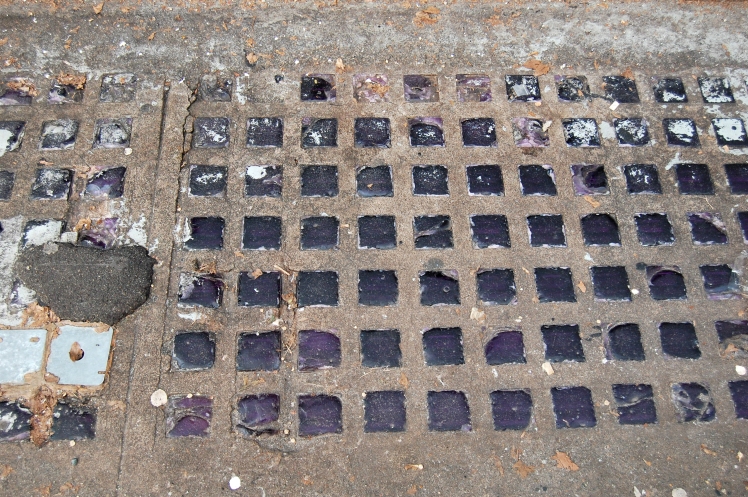
#7. 425 Carrall Street – Original. These sidewalk prisms are along the Carrall Street side of the former BC Electric Railway Co. building which dates from 1911-12. This building was the headquarters for BC Electric until 1957, after which the main floor streetcar barns were enclosed to house a bank. Unfortunately, the sidewalk prisms are in very poor condition and I fear for their future.

#8. 412 Carrall Street – Restored. Portland Hotel Society – Pennsylvania Hotel. The building was originally constructed in 1906 and was fully restored in 2009. This restoration included reintroducing the sidewalk prisms above the basement areaway. This is another excellent restoration which takes into account the sidewalk load restrictions for areaways and sidewalk prisms as laid out by the City’s Engineering Department.
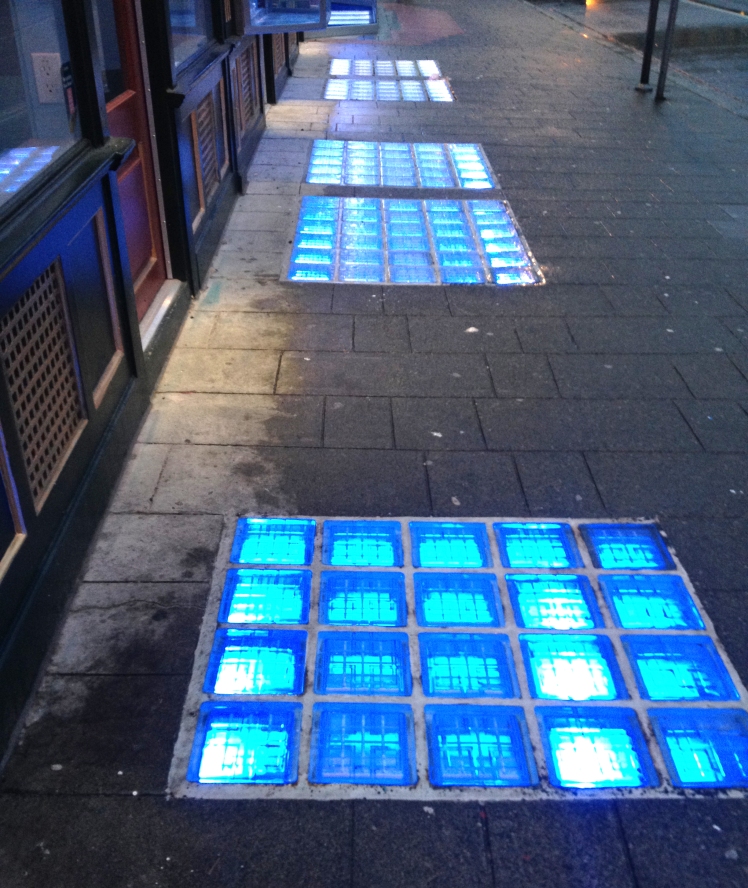
#9. 8 West Pender – Restored. Sam Kee Building. This internationally renowned narrow building was built in 1913 and includes a lower-level extension beneath the sidewalk, in which original owner, Chang Toy, created a public bathhouse. The glass blocks in the sidewalk are illuminated by coloured lighting underneath, so to be visible from above.

#10. 212 East Georgia – Original (preserved?). This is a lovely, small example of a preserved piece of history at the entrance to the Brixton Pub. This four-story section of the historic (1903) London Hotel (208 East Georgia) was built in 1910. I really like this sample as it proves that a complete restoration of sidewalk prisms and areaways is not always necessary/practical for historical impact. In this case, a little goes a long way. (This may be a perfect point in the tour to stop for a bit of refreshment).

#11. 260 East Georgia – Original. Outside the Tin Lee Supermarket (located in a two-story brick building that possibly dates from 1909-10) in the heart of Chinatown, these prisms are an excellent example of what you would have seen all over Chinatown at one time. The sidewalk prisms are often covered by produce display boxes, which may be assisting in preserving them or hastening their deterioration. Hopefully, it is the former.

#12. 1014 Main Street – Original. In front of Bodega on Main, these are an interesting example of original purple sidewalk prisms. They appear to have been covered by some sort of “clear varnish” that has discoloured over time. Ostensibly this was done to preserve the integrity of the prisms and prevent further deterioration? According to some accounts, the areaway beneath the sidewalk is still in use and is accessible from the restaurant. (If you didn’t stop at the Brixton, perhaps a stop here is in order).

If you have time for only one stop on the tour, then 500 block of Beatty Street is the place for you – a sidewalk prisms mecca!

#13. 564-566 Beatty Street – Restored. The sidewalk prisms in front of the Beatty Gate building (1909-1912) have been restored according to the sidewalk load restrictions for areaways and sidewalk prisms as laid out by the City’s Engineering Department.
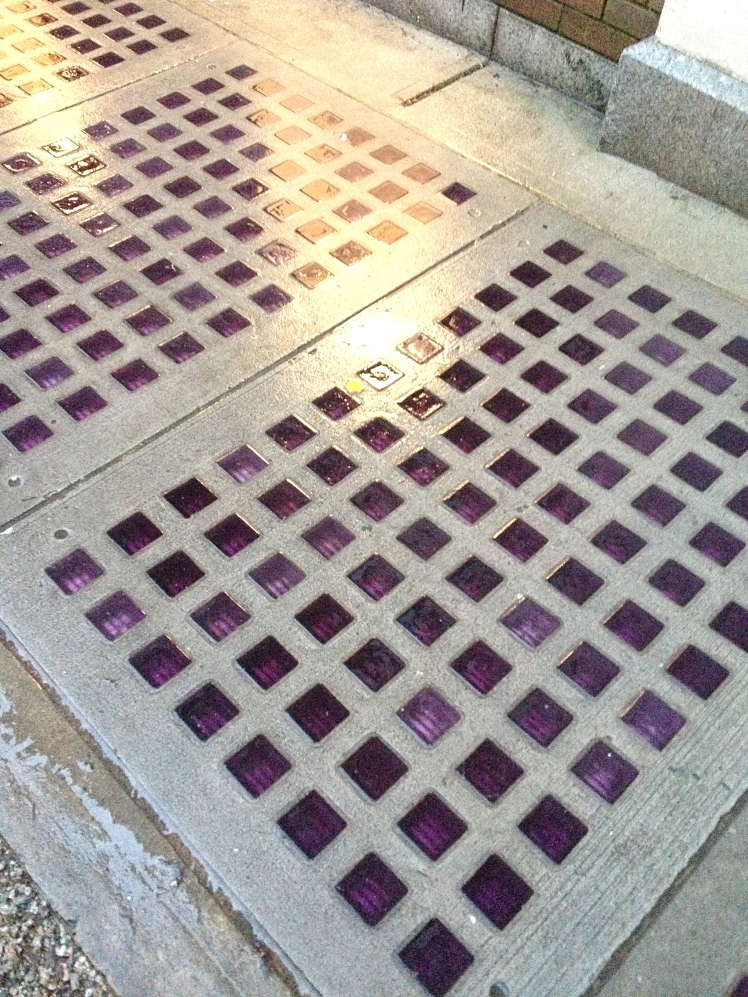
#14. 540-546 Beatty Street – Restored. This is a grand display of sidewalk prisms in front of this former industrial building. The sidewalk prisms were restored utilizing purple glass to mimic original historic sidewalk prisms. My favorite example of restored sidewalk prisms, as they are the most faithful reproduction of the historical sidewalk prisms commonly found in old Vancouver. The areaway beneath the sidewalk is accessible from the lowest floor. The Crane Building was built in 1911-12 as a warehouse, showroom, and offices for Crane Co., suppliers of steam, mill, and plumbers’ supplies.

#15. 2545 Main St. – Original (but covered). Serendipitously found along the E. 10th side of Belvedere Court (formerly the Harris Block), which dates from 1911-12. I was very happy to discover this example of sidewalk prisms for several reasons. First, the location is outside of the downtown core but still located in a historic Vancouver neighbourhood (Mount Pleasant). Second, it is a visual example of what commonly happened to sidewalk prism lights, once they become damaged and a hazard – they were covered with asphalt and only an impression of them remains.

#16. 367 E. Hastings Street – Original. This excellent example of original sidewalk prisms is located in front of a brick building, constructed in 1911 for G.A. Hankey. It was originally known as the Hankey Block and was home to Holborn Rooms, a rooming house/hotel.

#17. 1180 Homer Street – Restored. Outside the Mc Master Building a 1910 brick building, designed by Campbell & Bennett, that was completely re-built ca. 2006 utilizing the original facade. Historic looking purple glass sidewalk prisms were incorporated into the re-build.

#18. 1026 Davie Street – Original. These partially hidden remnants of sidewalk prisms are located in front of a building built in 1911/12 to house a dance academy and apartment house. (Previously home to the Embassy Ballroom, Dante’s Inferno and the Retinal Circus, it is now Celebrities Nightclub.)
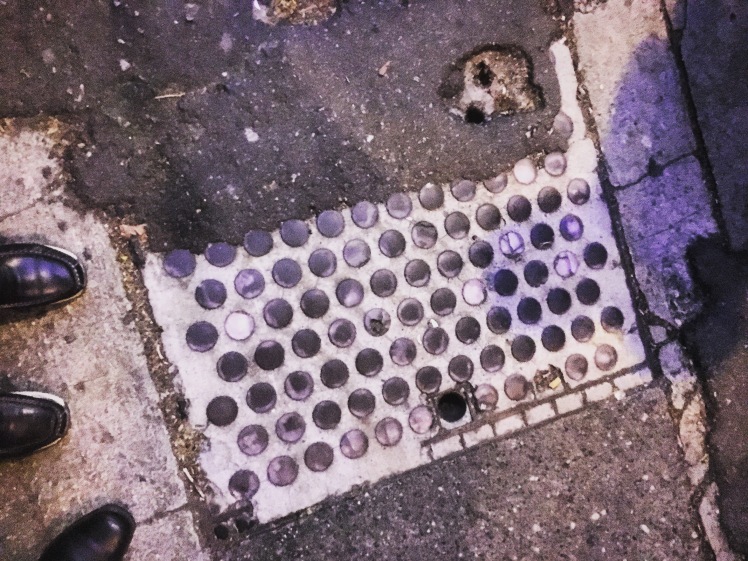
#19. 422 Richards Street – Original. This example of round sidewalk prism lights – which is rare for Vancouver – are found outside the old Bank of British Columbia / Northern Crown Bank Building constructed ca. 1901. [Ironically, I “discovered” this example while on a 2019 Jane’s Walk of Sidewalk Prisms! The walk leader used this resource for the tour.]

#20. 42 East Cordova – Original. This well-preserved example is found at the entrance of the building. Although this building appears today to be one structure, it was built in two parts, with two different architects involved. For many years, two hotels operated here, one at 42-44 East Cordova (Arno Rooms/Central Hotel) and the other at 48-48 1/2 East Cordova (Oliver Rooms). The eastern part of the building (48-48 1/2) was erected in 1911 by Hemphill and Company for owner W.C. Marshall. The architect was Hugh Braunton. The western part of the building (42-44 East Cordova) was erected in 1912 by William O’Dell for the Vancouver Realty Company and designed by A. Campbell Hope.
#21. 50 East Cordova – Original. Like its next-door neighbour (see #20), the small sample of prisms is in good condition and is located at the entrance. Originally called Cordova Rooms, the hotel was built in 1912 to designs of architect Hugh Braunton as a speculative development for D. Campbell. The significance of this building is amplified by its location adjacent to 42 and 54 East Cordova Street, both hotels designed the same year by Hugh Braunton, and possessing very similar architectural treatment.
Excerpts from CBUT’s “Summer Afternoon” featuring sidewalk prisms on East Pender St. in 1957.
Recently, I have been noticing the occasional nod to Vancouver’s sidewalk past with new building developments. Modern interpretations include square grid patterns in the concrete or even contrasting squares embedded in the sidewalk. Take for example the sidewalk outside The Crossroads development at Broadway & Cambie, there is no denying that these green squares are reminiscent of the sidewalk prisms of the past.

Special thanks to heritage architectural consultant, Donald Luxton for meeting with me in person and providing me further illumination about sidewalk prisms and filling me in on areaways in Vancouver (no puns intended… well, maybe just a little).
I learned so much information about sidewalk prisms and architectural heritage that there was no possible way to fit it all in one post. Update: I wrote about Sidewalk Prisms for Scout Magazine, in April 2018. That version includes a cool interactive map, but only includes 17 of the stops.

Fun Fact: The reason original sidewalk prisms are purple is that manganese was added to the glass in the late 19th and early 20th Centuries. When exposed to UV light or sunlight, the manganese turned purple or amethyst over time. The amount of manganese added determined how deep a purple colour the glass would turn.
Update: In February of 2017, I discovered another set of original sidewalk prisms on the 300 block of E. Hastings (stop #16). I’ve updated the walking tour map and this post to reflect this addition. After I wrote my Scout piece a reader told me about another set of sidewalk prisms at 1180 Homer (#17). Then there were 18! Another set of prisms at 1026 Davie Street. Let’s add one more! We found #19 by chance on a 2019 Jane’s walk that featured the sidewalk prisms of Vancouver led by walk leader Cara Fisher based on the information found in this blog post. In the fall of 2019, I found 2 examples of sidewalk prisms along E Cordova which brings the total to 21!
In December 2022 I chatted with Eric Chapman on CKNW’s Where We Live show about prism lights.
“When you walk around downtown Vancouver… Have you ever looked down and noticed those purple bricks made of glass? Well, if you have noticed them and ever wondered what they are, community contributor Eric Chapman went and found out.”

Again I am so incredibly impressed. Well done!
Sent from my iPad
>
Thanks!
Thank you for this thorough look at Vancouver’s sidewalk prisms. I am in Buenos Aires where they are also numerous.
Thanks, it’s interesting to hear that Buenos Aires has many sidewalk prisms. I imagine that they are all original. Are there any restorations like in Vancouver?
Thank you for the answer to a question I didn’t know I was asking! Part of my brain may now rest….
Glad to help!
Hey just thought you should know there’s also some paved over sidewalk prisms in front of the Heartwood Cafe at 317 E. Broadway, the asphalt is pretty thin and you can definitely make them out. I’m not sure how old the building is but it looks like the oldest on the block. I also have a feeling i have seen more random bits of un-maintained prism sidewalks scattered in east Vancouver. I love looking for stuff like this. I remember reading New Westminster lost it’s glass sidewalks to safety issues but Victoria also has a great history of prism sidewalks with many still intact. This website has some great images of the large panels removed, the below area and the individual tiles removed http://www.islandnet.com/~jar/streetscapes/topics/prisms.htm
Enjoy!
Hi Retroorange
Thanks for the sidewalk prisms siting! Coincidentally I was looking up that cafe on the internet yesterday for another reason… how cool! I will check it out and add them to the list! I know all about the most excellent website from Victoria and the images they have of prisms. There was a lot of stuff I wasn’t able to fit into my post, that was one of them. I think I will add a list of resources ( including that one) that I think might be interesting to readers at the end of the post.
thanks!
The reason for the purple glass is interesting. This purple colour probably reduced the amount of light. Do you know if this purple manganese glass was used in other parts of the world. Thanks for the article…I was always intrigued about these glass prisms and knew they were to let light below, but now I know the whole story.
Yes, I imagine the purple prisms would greatly diminish the light entering. It appears that manganese was an additive for glass in other parts of the world including the UK and US.
Very interesting post. I was just down in Cambridge (Boston) for two weeks and my friend, a local, pointed out the purple windows in old houses, which is very common. I forgot to Google the reason for the purpleness, but now I don’t have to – manganese!
Thanks, and so cool to hear that windows also became purple over time. I’ve seen examples of more decorative purple glass, but never knew about windows. But it makes sense if manganese was part of the glass formulation.
Reblogged this on Running With the Copier and commented:
Sidewalk prisms a walking tour around Vancouver. Some very interesting facts and answers to how come these are in the sidewalks.
There can I get info on the walking tours. Visiting from UK in Sept and would love to know more of the city’s history
If you are looking for info on walking tours in Vancouver I would simply do a Google search for “walking tours Vancouver” or “walking tours Vancouver history”. There are quite a few options to choose from. Some of the historical groups offer tours, some companies offer them as well. I did a post a couple of years ago on walking tours in the area It may give you some ideas. Good luck!
https://vanalogue.wordpress.com/2013/07/15/historical-walking-tours/
http://www.tourismvancouver.com/activities/sightseeing/10-first-time-experiences/ How long will you be here? Also see my Pinterest board has much to choose from. https://www.pinterest.com/tapestryiii/travel-british-columbia-canada/
Fantastic! Thanks so much for the info.
Thank you!
Thank you for writing this article. I discovered prisms on the Underground tour in Seattle and was thrilled that prisms also existed in my hometown of Vancouver. What I didn’t see was if you experienced the view from underneath. It was amazing that the purple glass that looks so opaque from up top and when you go down underneath it’s completely clear, even on a cloudy day. I’d love to hear of how you could view these sites from the basement view.
Thanks for your comments Devon. Last fall I was in Seattle and regret not taking the tour to see the view from underneath. (you may notice that one of my photos features the round prisms found in Pioneer Square). To my knowledge, the is no public subterranean access to the sidewalk prisms and areaways featured in my post. I suppose the only way is to ask permission of the business or property owner.
Have you been to Calabash Bistro? There are sidewalk prisms at the entrance. The really cool part is that the bar downstairs actually extends beneath the sidewalk. You can see them from below on the way to the washrooms. It’s on 428 Carall St.
Yes I knew about those prisms outside Calabash, I included them in my stop #8 as they are part of that restoration (though I didn’t indicate as such). What I didn’t know is that you can actually see them inside the restaurant! How cool! I will have to make a stop there soon!
Great post. There’s also sidewalk prisms outside of Celebrities on Davie.
Thanks Brett. And thanks for the tip about sidewalk prisms outside Celebrities on Davie, I will definitely check that out.
Your photos are lovely. Could you please contact me about using them?
Apologies for the double post. There is access to the areaways under some of Vancouver’s sidewalk prisms, as there are restaurants there; see the Wikipedia article for a link to them.
Thanks for the info. I knew about some of them. I was lucky enough to travel to San Francisco last year and see some sidewalk prisims from below at City Lights Books…very cool.
Love this post. Was admiring some lights today in front of Celebrities Nightclub on Davie St that could be added to your list.
Cheers!!
Thanks! Yes I know about the celebrities Nightclub sidewalk prisms…. I included them in my updated post I did for Scout Magazine… this version has the interactive map… check it out at: http://scoutmagazine.ca/2018/04/30/hunting-vancouvers-forgotten-sidewalk-prisms/
Very interesting! Is there anyone making or duplicating the prisms for repairs and or replacement? I’m in california and cant find a source…
Hi Manny, that is a great question… not sure if this will help but I found this: https://glassian.org/Prism/current.html
Hope it helps.
amazing post captures the forgotten sidewalk prisms in Vancouver.
The Pavement Light company manufacture pavement lights also known as vault lights and sidewalk prisms
view the website link below to find out more about replacement and repairs.
https://thepavementlightcompany.com
https://thepavementlightcompany.com/products-and-services-1
Thanks for sharing the links to The Pavement Light Company, Justin!